
A dentist's advice
DIY ultrasonic cleaning has gained prominence recently, and an increased number of products are being advertised for it.
But that doesn't mean it's a good idea.
It is unnecessary for plaque removal, and you can't use it to remove tartar instead of going to the dentist.
An ultrasonic tooth cleaner that you can use at home might sound like a good idea. You might be hoping this will save you a trip to the hygienist. But alas, it's too good to be true.
Having tested a few of these products, in this article I give my opinion and advice as a dentist.
What is an ultrasonic tooth cleaner?
I am talking about ultrasonic tooth cleaners that are marketed for you to use at home. These are different to the scalers used for professional cleaning.
These are products you can buy online and in shops.
These products make claims that they remove plaque, tartar and stains by using vibrations.
They typically have a metal tip, although some also come with alternative tips such as a rubber based cleaner. They are powered devices, using removable or rechargeable batteries.
DIY ultrasonic tooth cleaners can be called a few different things. Names I have come across include:
- Ultrasonic Tooth Cleaner
- Sonic Home Dental System
- Electric Plaque Removal Tool
- Electric Interdental Brush
- Electric Dental Calculus Remover
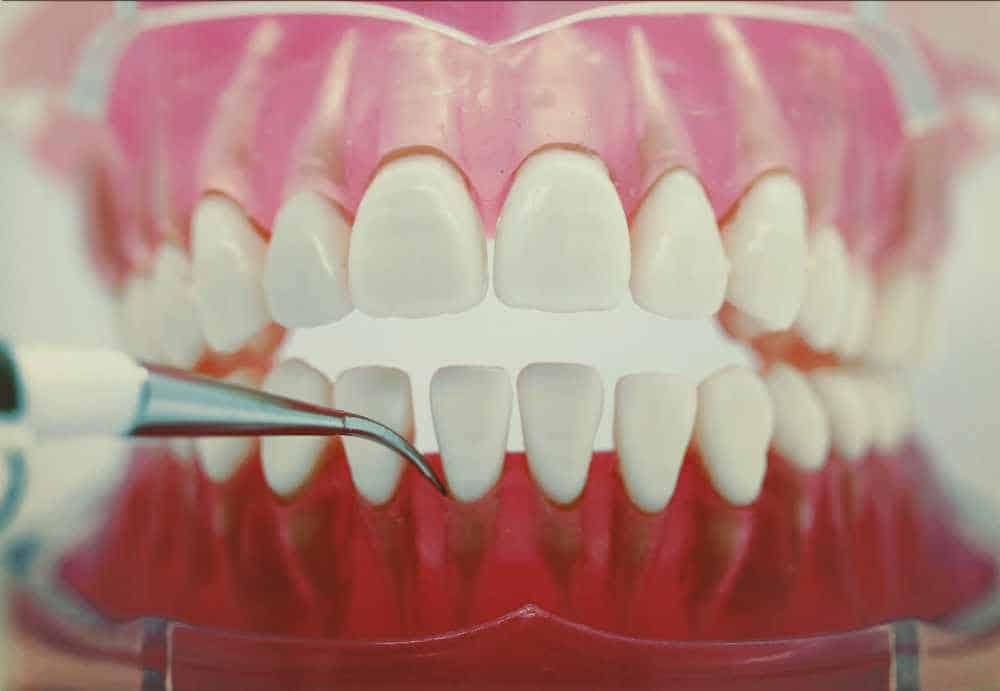
Why it's a bad idea to use products like these at home
We purchased and tested two different types of at home dental scalers.
After trialling two different products, I can better explain the problems with at home calculus removers.
The potential problems are divided into damage they can do in the mouth and false manufacturers' claims.
Ultrasonic cleaners will damage your teeth and gums
DIY dental scalers can damage the gums. The sharp metal tip will traumatise the gum if used incorrectly. High vibration rate will also irritate the gum disease and cause damage, especially because there is no water flow.
Ultrasonic scalers can dent and scratch the enamel surface if used incorrectly. This is also true for professional scalers, which is why, as dentists, we are trained in how to use them safely.
The at-home ultrasonic cleaners can damage existing dental work. This includes white composite fillings and metal fillings. They could also scratch crowns and veneers too. Scratching these surfaces will make them more prone to staining and plaque buildup.
Using a scaler which has high vibrations without water can cause the tooth to overheat. This will damage the nerve of the tooth in the pulp. Ultimately, this can be irreversible and result in the tooth dying off. In the models I tested, they did not vibrate fast enough to produce heat.
Such instruments bought in a shop and used at home are not sterile. You could, unknowingly, bring harmful bacteria into your mouth and underneath your gums which could cause an infection.
You cannot clean them effectively at home. When these go in the mouth, they pick up the bacteria that are on your teeth and under your gums. Cleaning products you have at home will not full clean the surfaces of the scaling tips.
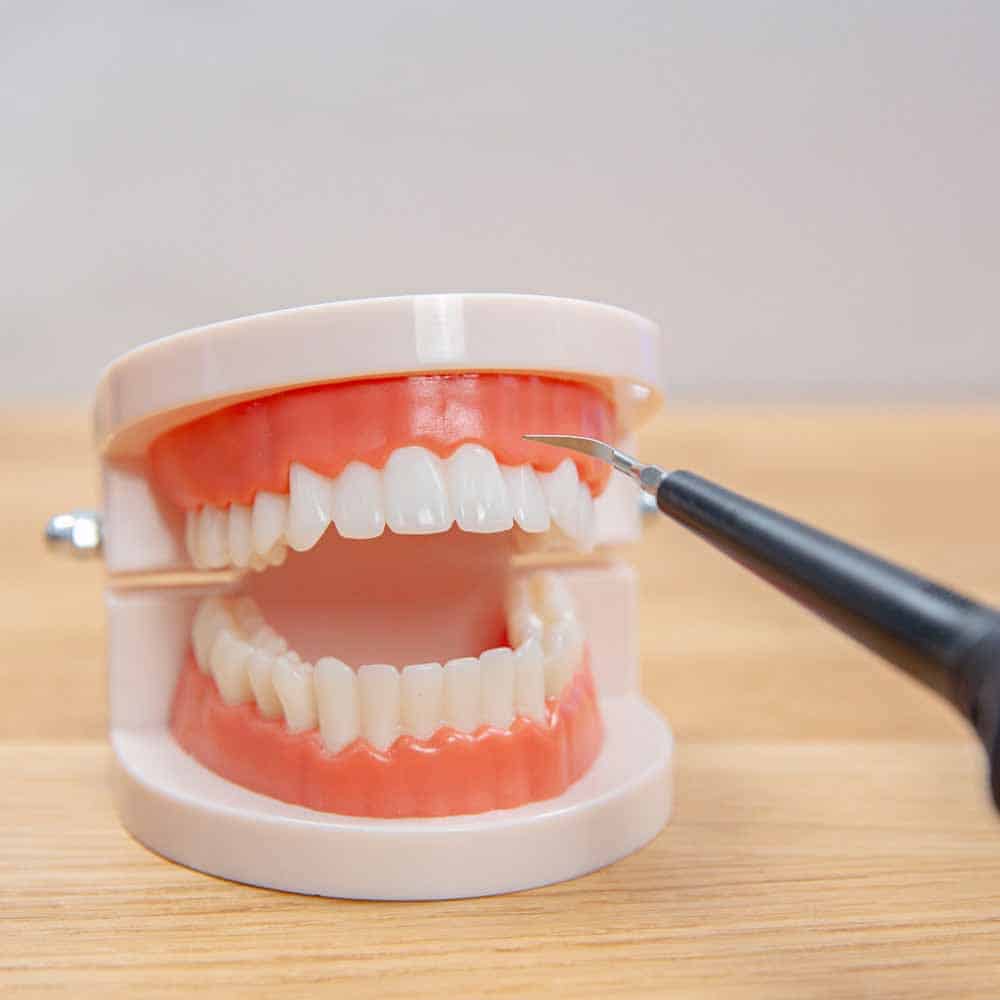
Beware of false promises from manufacturers of DIY scalers
At home ultrasonic scalers don’t really work.
It is very difficult to remove stains from teeth using these products. I have only very light staining and found this a challenge to remove, even when using the correct movements I know from dental training. It is unlikely you will get the effect you desire at home.
I am not convinced they will remove tartar/calculus as promised either.
The manufacturers are claiming these are safe, even for children. The JML manual says that children from age 8 can use the product, as well as “persons with reduced physical, sensory or mental capabilities”. I would disagree. Most children don’t have the right dexterity to be able to brush effectively, let alone use a sharp metal instrument in their mouth!
By purchasing these products you will be wasting your money. The extra plastics and materials used place an unnecessary burden on the environment for an item that doesn’t work.
Products I tested
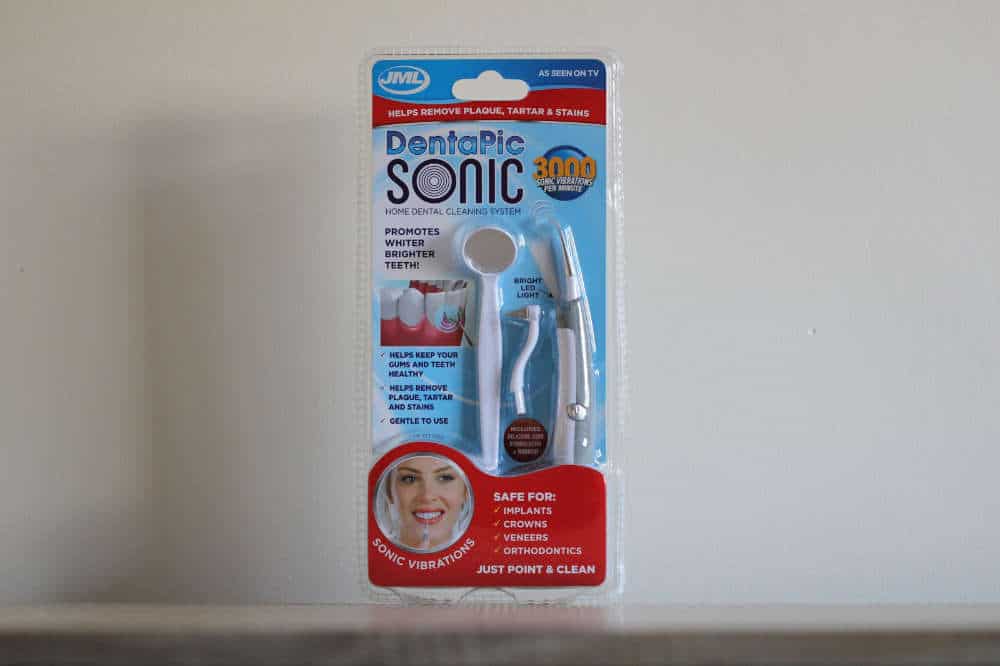
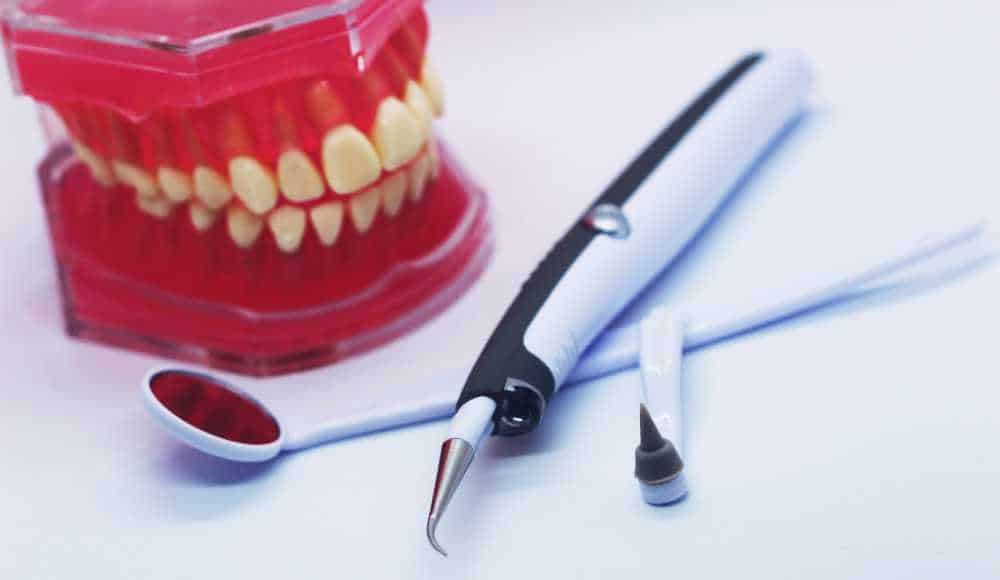
The first was the JML DentaPic Sonic (picture above). I unboxed it, read the manual and set it up to go.
The handle has an on/off button and a light.
My first thought was about how sharp the metal tip is. I would strongly advise against anyone except adults with good mobility putting this anywhere near their teeth or gums!
I tried it on my fingernail first, and was surprised by the power output. Next I tried it on my teeth. I have a small amount of staining between my lower central incisors so thought I should start there.
Does the DentaPic Sonic remove stains? Yes. But it took a long time and it didn’t even manage to completely remove a small stain. The sharp tip also actually scratched the enamel surface a little bit and damaged the white filling material in place for my Invisalign treatment.
I also tried the scaler on a mock up of calculus. I applied PolyFilla (a multipurpose hole filler for walls) to a denture and allowed it to dry. I then used the scaler on the denture. It did cause the top layer to flake off, but otherwise it just scratched into the white filler material.
Will it remove tartar? Unlikely. On using it with the metal tip, I can feel that the vibrations are not enough to remove calculus. The metal tip was sharp on the gums, and I really would advise you to avoid using this unless you know what you are doing.
Even if you do have the skills to not damage the gums, the scaler doesn’t actually do anything.
I also tried the rubber tip. This was useless. The vibrations that come from the hand tool aren’t transmitted down the silicone (due to it being a flexible material). So this also doesn’t remove any stains or tartar. It’s not fine enough to clean between the teeth to replace other interdental cleaning methods either.
Overall, a waste of money!
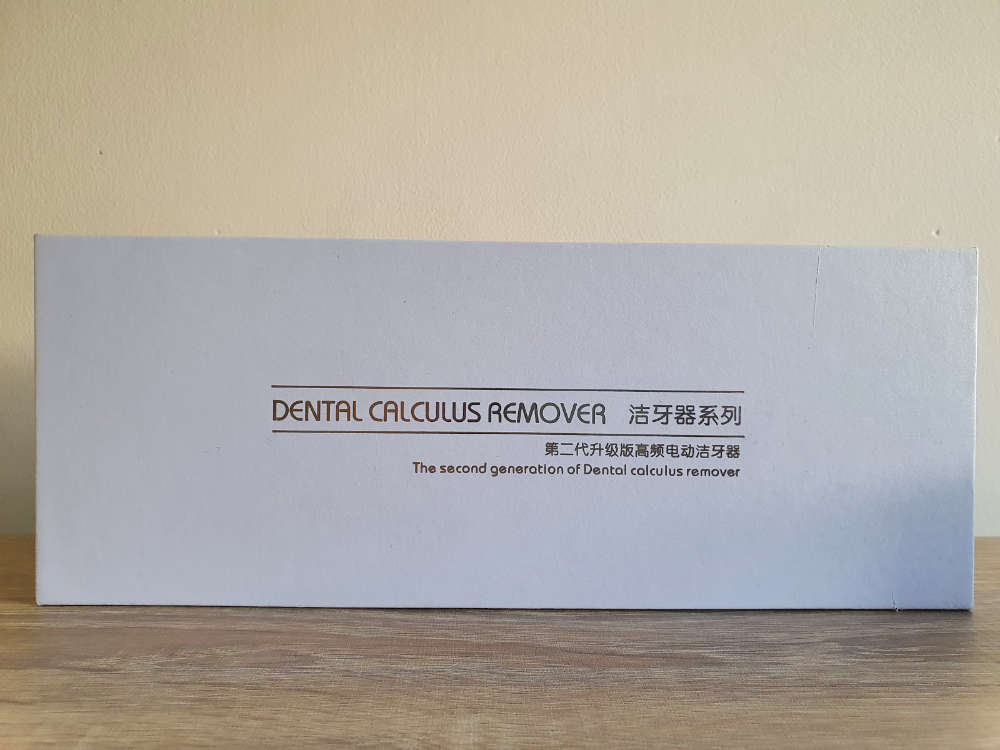
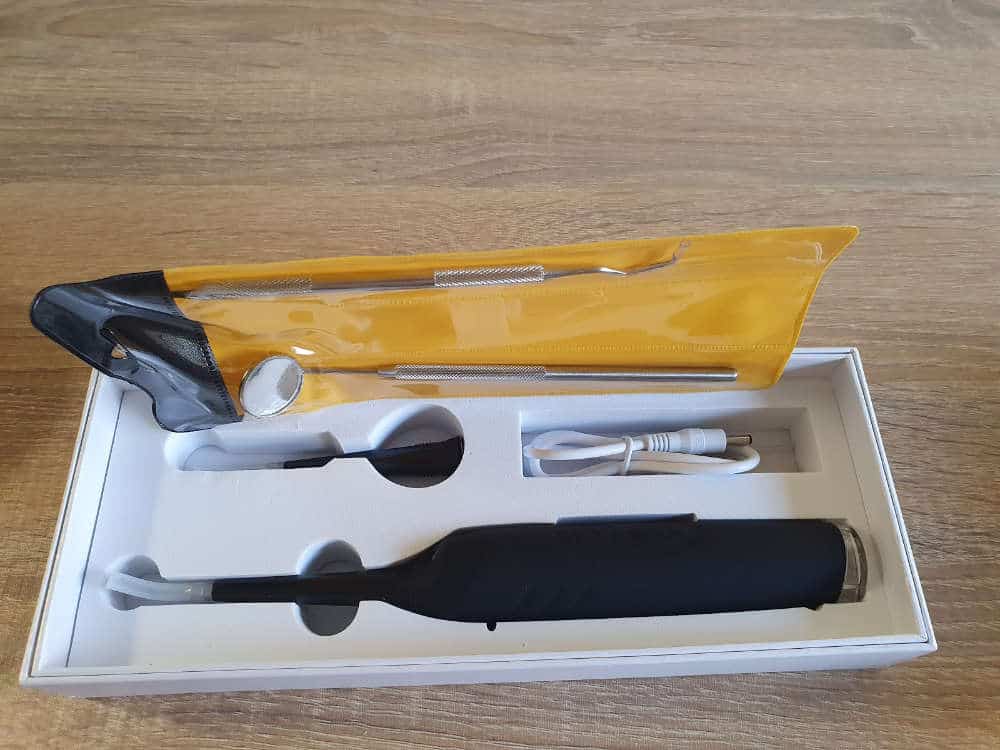
The second product was from Amazon — “the second generation of Dental calculus remover” (pictured above). This rechargeable option came in a white box.
There are two different metal head attachments. The scaling tips actually look very similar to the professional scaler tips. The handle has three different speeds and an in-built light.
I read the instructions, whilst waiting for the handle to charge. Reassuringly, this product advises against children using it.
Again, I first tried it on a fingernail to get a first impression. This one seems to have a higher rate of vibrations, in my opinion. This time I tried it on a bit of staining between the upper left canine and lateral incisor.
It does definitely remove stains. It takes a while though. Again, when I tried it on the composite buttons for my retainers, there was some damage.
When I used this scaler on the Polyfilla’d denture, it was less effective than the JML scaler. Like the JML scaler, it flaked off the very fine dusty layer of filler. It also scratched into the filler layer. But it definitely did not remove the filler in the way I would expect a scaler to.
Will it remove tartar? Maybe. But probably not.
Similar products to those I have tested
Although I haven’t tested the following products, the specifications are very similar to those I have tested and therefore they are unlikely to be effective.
But regardless of their effectiveness, the same advice applies about them having the potential to damage your teeth and gums, and therefore I don't recommend using them:
- Smirk ultrasonic tooth cleaner
- Sonoshine
- Smile therapy
- Teeth saviour
- Dentrie
- Ivory Oral
- Sanipik
- OnlySmiles
- MyOralGift
- Densine
If you come across any products similar to these, please let us know in the comments section below.
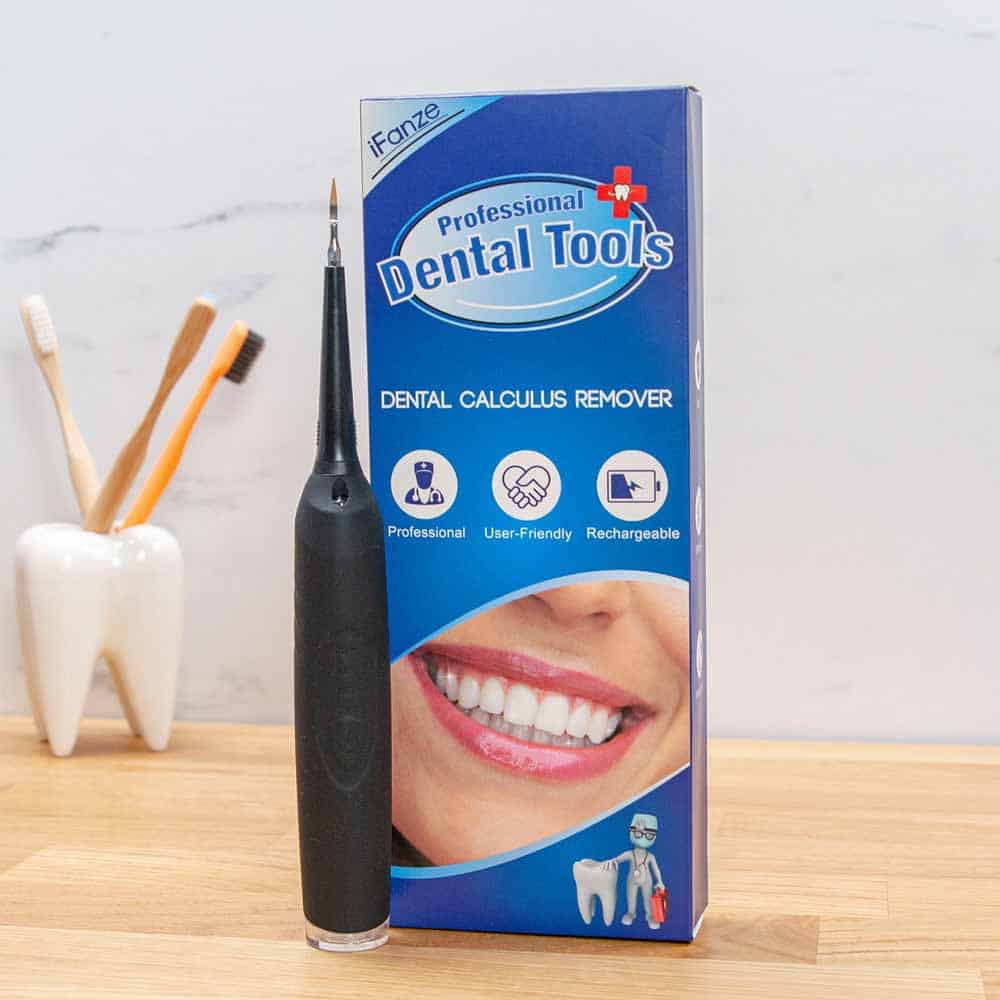
How do these differ to ultrasonic cleaning you receive at the dentist?
Professional ultrasonic scalers are used by dentists and dental hygienists. They remove tartar and staining from above and below the gum line. They can be powered via the dental chair or as a separate unit.
These at home scalers do not move as fast as professional scaling tips. Professional ultrasonic scalers vibrate at a speed that is faster than you can hear (ultra sonic). This is somewhere between 20,000 and 45,000 times per second. There are also profesional sonic scalers that vibrate 3000 to 8000 times per second. The tips I tested were less than this.
These at DIY scrapers do not have a water supply. All professional scalers have a water supply. The purpose of this is to help cool down the metal tip. The water flow also helps the cleaning mechanism underneath the gum level.
It is possible for professional ultrasonic scalers to damage the enamel surface of the teeth and dental work. This is also true for the DIY tartar removers.
In fact, a lot of the problems I have listed for these at home scalers are also true for professional cleaning. The at home scalers move fast enough to cause damage, but not enough to be effective!
The main difference is that dental professionals know how to handle the tools to avoid causing damage. They can also identify any damage caused and remedy it, something which is not possible at home.
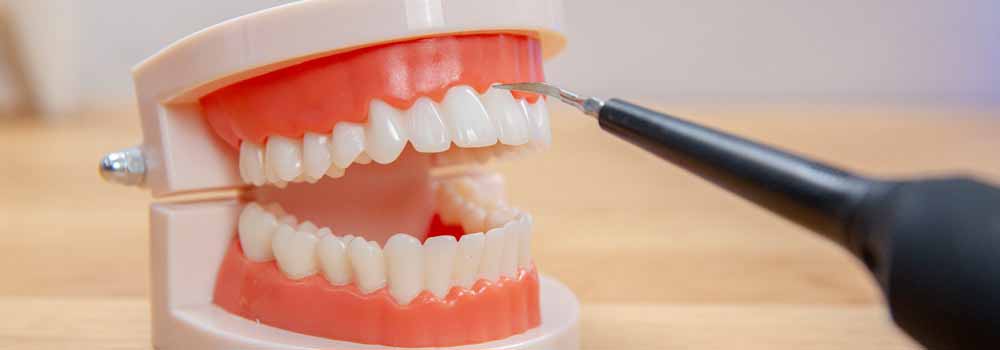
What to do if you are considering buying one of these products
Simple answer: please don’t buy an ultrasonic tooth cleaner to use at home.
There is no need to purchase one of these DIY scrapers to remove plaque. Plaque does not have a strong bond to your teeth and can be removed with toothbrushing and interdental cleaning.
You aren’t able to use anything to remove tartar without going to the dentist. The bond between the tartar and the tooth surface is too strong.
Instead of buying one of these products, invest your time and effort into getting into a good oral hygiene routine.
Preventing plaque build up will improve your oral health. Removing plaque helps prevent tartar and staining.
Small changes in your diet can also reduce staining. For example, avoiding foods that stain your teeth, or rinsing after having staining drinks such as coffee.




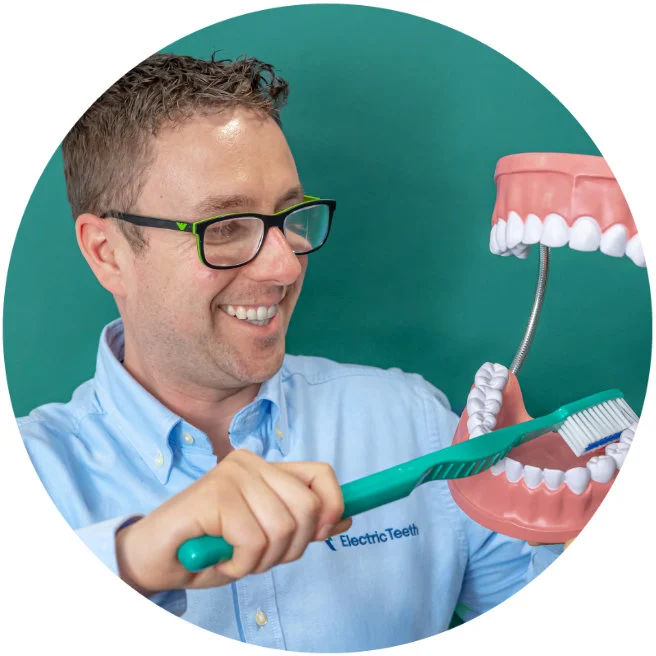
You make some good points, but you overdid the warnings by saying it is impossible to clean a metal instrument at home. One can sterilize many things at home with bleach and other ways. At the top you mention being able to remove plaque but not tartar. If anything, it's the other way around.
salve sono Nicola Russo, mi hanno regalato un dental tools elettrico teeth cleaner with led screen. iFanze
volevo sapere se possibile avere ricambi di spazzolini da denti, sempre se ci possono andare bene,e dove trovarli
grazie
Ciao Nicola.
Ti consiglio di contattare il produttore di questo prodotto. Presumo che il loro sito web sia https://ifanze.net/
grazie
I’ve been searching for an ultrasonic plaque remover, after discovering the product by happenstance just this evening. I was intent on purchasing one tonight when I scrolled down a page or two and came across your very convincing article. Thank you for saving me from making a serious mistake.
Thank you for your information.
I have no dental training. But I have two problems with this review:
(1) 100% these sonic metal tipped tools will remove caked on yellowy tarter/plaque. I know nothing of the safety and too me they seem risky. But 100% from personal experience, these things will take off caked on crap that a toothbrush will not.
(2) this review states it is not possible to clean these tools. Why not? If I soak it alcohol or bleach, the how is that not clean? Surely it is at least as clean as an ordinary toothbrush. When an endodontist cleans the inside of a hollowed out tooth they use bleach!
Exactly. I also went to my dentist whose more well known, however the aspects that made me eye-roll this article were the following:
Retainers - veneers - false teeth - cavities etc - it can result in overheating tooth, to sharp an end, not ‘fast enough’, or ‘the right amount of fast, ultrasonic - faster than we we can hear’ both have ‘risks’ if we ‘do it wrong’. Not everyone is incapable
But does this WORK? Yes it actually works. This dentist was trained in her annual meetings to help combat companies like this. Make no mistake, it’s because the industry doesn’t want you to know. Of course they want people to protect their natural teeth, but that is why it’s important to be succinct, honest, clear in your message otherwise it’s overzealous vs aloof and diminishing.
Give people the benefit of the doubt but allow disclaimers and honest warnings.
We can clean it with denture cleanser, too, and multitude of various products this makes it sound like the lot of us have a grade 7 education. It really dismisses people who are reading it.
. First, it discusses that it can affect multiple types of materials (listing several things before ‘actually regular normal teeth’
. Goes into assuming you’ll use it incorrectly. I went to my dentist who taught me how to use and confirmed I was using it correctly.
. If used correctly, no - the ultrasonic part of this product is not unsafe. It’s like anything…you can even damage gums if you’re not using a regular toothbrush properly. This dentist talks like she’s deathly afraid of losing clients and affecting the industry, a newer dentist with less education and experience than my dentist.
Im disappointed in those that participated in writing the article. The most recent doctor who edited the article was not honest or forthcoming. She’s known for not writing honest and forthcoming articles like this.
Thanks for the input--i wass consdering buying,their positive reviews & testimonials are the only thing you see ,unless you can find and click on the negative reviews,better to stick with my electric tooth brush and use a waterpick flosser reccomended by my dentist.
These devices are getting better and better. I recently bought one from Amazon (Nov 2022) by a brand name: Morkare with positive reviews by actual purchased users. Product claimed 2 million vibrations per min, and came with Two sets of cleaning heads. (Flat and pointed) It stops when the tip hits the Gum. So far it worked fine. Loved the results. Look at the progress of the electric toothbrush over the years. Like I said, technology of these devices are getting better.
Thanks. Great review. Makes complete sense. Not worth damaging teeth, crowns, fillings etc to try these products out. Their sale tactics are pretty slick - like click now for 50% off. So thankful you brought a fair and balanced review to the table!
Thank you for the feedback Erin. Gemma
They work great for me and save me money that you’d prefer went into your pocket. Dental cleaning is simple and anyone can learn to do it like so called professionals. I will pay you if I ever need dental surgery though I promise.
Best investment of the year. So satisfied and they work great! Do not listen to a lying dentist worried about their own pocketbook.
Just so we're clear -- by "ultrasonic tooth cleaner", you don't mean ultrasonic toothbrushes, right?
Correct Claudio.
I’d have to say this article is mostly a clickbait devoid of any real data on the topic with an honest admission at the end that same issues are also present at the dentist’s office especially nowadays that rarely a dentist does cleaning; ill go over a few things from the article that can be mitigated:
1) in terms of lack of water, that’s easily mitigated by concurrent use of something like waterpik or any other water flossing system
2) “ enough to cause damage, not enough to be effective”; very untrue; these little devices can be extremely effective, by my own n=1 experience that after 3 years of not going to dentist (due to covid mess), i used one of these devices and when few months later i finally made it to the dentist, they barely found anything to remove
3) “sharp end can cause damage if not used appropriately” …well then use it appropriately. Also many of these devices come with different types of tips, some of which are rounded tip that would cause less damage
I do understand why dentists would like to discredit these devices but sooner or later, tooth cleaning will become a diy home technology whether they like it or not.
I wish I had read your article before I purchased from Sonoshine. It is totally wasted money.
I’m curious about your experience with this product and did you ship it back?
In regards to sonoshine
I got this ad: https://www.youtube.com/watch?v=g4c2raUNKqc for SaniPik. (I imagine it won't stay up) I have to admit the video they use is pretty convincing but the claims just sound too awesome -- seems like from your post, they are.
Indeed the claims do sound impressive. Also misleading that the images of actual tartar removal from the tooth are of dental professionals using professional scaling tools, not SaniPik.
Paul C, the guy who invented it appears unwilling to share his full name. One would think if you were so proud of this remarkable invention you would share your full name and go on camera to talk about it potentially.
There is more that I can add, but I will stop there.
I do animal dentistry and one important step you left out is polishing. Any tiny scratches are buffed out by the tiny abrasive particles in the prophy paste. Without this you create the perfect base for plaque attachment. Polishing is as important as scalling.
Have you tried Sonic Shine to descale a dogs teeth
Good article! As a hygienist who started practicing before the slimline ultrasonic tips were invented, we had to scale almost all of the subgingival calculus by hand. Without the benefit of a water flush, loose bits of tartar occasionally would become trapped in the inflamed gums even with using a water syringe at the end of the appointment to flush things out as best we could some patients would present with a lateral periodontal abscess requiring further intervention. Once we were able to have the slimline ultrasonic tips we never saw post-op abscesses. Ultrasonics without water would be a nightmare though for the mouth: heat damage, scratches on the teeth and metal marks on crowns and fillings, tooth damage. Uh uh., no thanks. =o/
Oh, and one more thing, ultrasonic toothbrushes are the bomb. I have had patients who either wouldn't or couldn't clean interdentally. With good technique (I had them bring the ultrasonic brush to their appointment) the improvements were often dramatic.
Any particular brush you recommend?
I truly like the results seen from the Sonicare . Seeing the consistent improvement in patients' gingival health was amazing. The cleaning action extends into the gum pocket beyond the bristles because of the ultrasonic bubbles created. Technique is everything though. Use a 45 degree angle trying to tip the bristles into the gumline. Let it just sit in the spot being cleaned for a few seconds (vs. scrubbing with it) before moving onto the next few teeth. It is meant to be used with some water so you can't go running around the house chewing on your toothbrush.=D
What do you do when a hygienist happens to damage to your teeth, and the dentist blames the enamel loss on poor at home hygiene, despite having a lifetime of excellent dental exams, including the exam just prior to the cleaning in question? The other dentist actually walked over and bragged on my excellent oral hygiene. (She is no longer there)
I'm really upset about this. I've always taken very good care of my teeth. They have been very sensitive for a year now. It took months for my gums to stop bleeding and I have thin sharp places, grooves spaces and everything I eat sticks like glue.
Until I read this article, Every thing Ive read says these scalers can't damage enamel. I know they can from experience.
What should I do?
Hi Michele. This is not something we can advise on. Getting 2nd opinions and possibly, seeking legal advice and speaking to governing bodies is likely to be advisable in your case.
Thank you for your input and prompt reply.